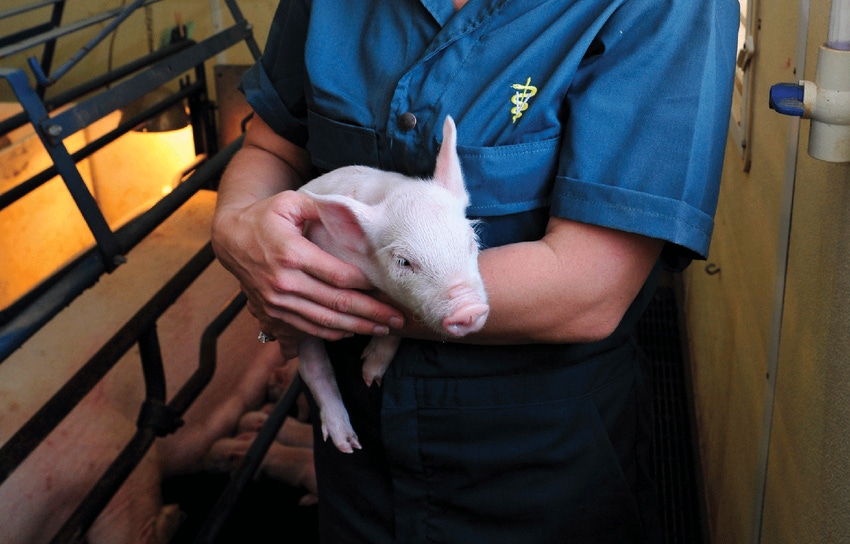Research Review: Any strategies that reduce stressful procedures will improve piglet health and welfare and have the potential to improve gains and reduce mortality.
December 26, 2018

Researchers: Erin L. Davis, Yolande M. Seddon, Sarah Ethier and Jennifer A. Brown, Prairie Swine Centre
Under the Canadian Code of Practice, swine producers must provide analgesics to piglets at castration to help control postprocedural pain. But with several analgesics on the market, producers are asking which products provide the most effective pain control, what the best age is to perform castration on piglets, and when the best time is to administer drugs to reduce pain. Those are three questions researchers at Prairie Swine Centre set out to answer in a recent project.
Comparing NSAIDs
In the first study, the researchers compared three nonsteroidal anti-inflammatory drugs: meloxicam, ketoprofen and paracetamol. One hundred sixty-seven male piglets from 33 litters were randomly assigned to one of five treatments:
1. Castration with meloxicam (Metacam 0.4 mg/kg [0.3 ml/kg])
2. Castration with ketoprofen (Anafen 3 mg/kg [0.3 ml/kg])
3. Castration with acetaminophen (Pracetam 60 mg/kg [1.0ml/kg])
4. Castration control
5. Sham castration
The analgesics were administered immediately before castration; meloxicam and ketoprofen were given intramuscularly, while acetaminophen was administered orally. Behavioral observations and physiological measures of stress were done on separate litters to avoid the stress of blood collection influencing piglet behavior. In total, 106 male piglets were studied for behavior post-castration, and blood samples were taken from 61 piglets.
Piglet age at castration
During the second study, 117 male piglets were randomly assigned within each litter to six treatments with three castration treatments (CAA, CA and SCA) and two ages (3 days old and 10 days old).
For piglets that received ketoprofen (Anafen 3 mg/kg [0.3 ml/kg]), the drug was provided intramuscularly 30 minutes prior to castration. Piglets were weighed and individually marked at two to three days of age and trained to navigate a handling chute one day prior to treatment.
Does timing matter?
In this study, male piglets from 35 litters were randomly assigned to one of five treatments:
1. Castration with ketoprofen, administered 1 hour before castration
2. Castration with ketoprofen, administered immediately before castration
3. Sham castration with saline administered 1 hour before
4. Sham castration with saline administered immediately before
5. Castration control, saline administered immediately before castration
Piglets were handled twice in the treatments where the analgesic (or saline) was administered one hour before castration, and only once where the analgesic (or saline) was administered at the time of castration. Thirty-five litters of pigs were used, with each treatment represented and randomly assigned within each litter.
How did they behave?
In all studies, behavioral observations were taken on piglets using a specially designed handling chute developed and validated as an objective behavioral measure of pain in castrated piglets.
On the day before castration, piglets were trained to walk down the chute to return to their home pen. Training involved four runs through the chute at intervals of 15 minutes, with the first run containing no hurdles, and the next three with increasing hurdle heights. This training was given to ensure piglets were familiar with how to traverse the chute prior to treatment application.
On the day of treatment application, all piglets were first given a pretreatment run at 30 minutes prior to administration of treatment. Following treatment, piglets were tested in the chute at 15, 40, 60 and 120 minutes posttreatment.
The results
In the first study, there was a significant effect of treatment on navigation times in the handling chute. Piglets given no pain medication had a significantly longer navigation times than piglets given ketoprofen, suggesting that pigs given pain control benefited. However, all other treatments were similar, and overall, piglets’ navigation times did not agree well with previous results.
The researchers identified two possible reasons for the unexpected results. First, some additional handling was performed before castration and may have influenced pigs’ movement in the handling chute. Second, the drug treatments ideally should have been given at least 30 minutes before castration, not at the time of castration, in order to see benefits resulting from pain control.
Based on the cortisol results obtained in the three studies, providing pain control showed a benefit in terms of reduced cortisol levels. In Study 2, significant benefits were observed when older piglets were provided pain control at castration, but no reduction in cortisol was found in younger piglets. In Study 3, providing ketoprofen 30 minutes before castration reduced pigs’ cortisol response and gave the best result.
In this study, providing the drug immediately before castration was significantly better than castration without any pain control. Since cortisol is considered one of the most reliable indicators of pain, the researchers conclude that the analgesic, ketoprofen, is effective at reducing pain when given 30 minutes before castration.
However, analysis of results is ongoing, so whether there are benefits when analgesics are given immediately before castration is still unclear.
Observations of piglets’ behavior in the farrowing crate will also be included in the researchers’ final conclusions. Any strategies that reduce stressful procedures will improve piglet health and welfare and have the potential to improve gains and reduce mortality. For producers providing pain control at castration, this research highlights the key considerations for achieving effective pain control.
For more information, contact Jennifer Brown.
You May Also Like



